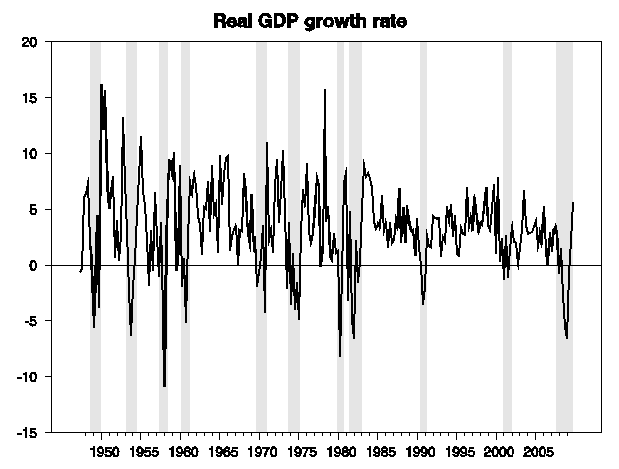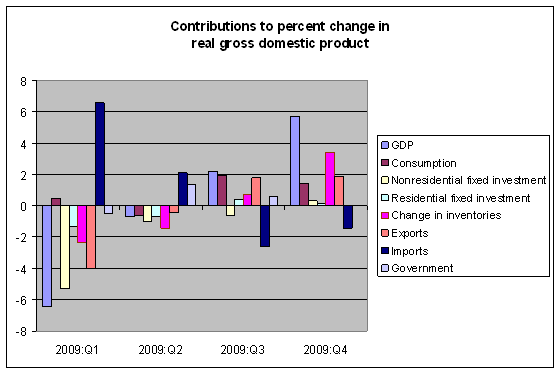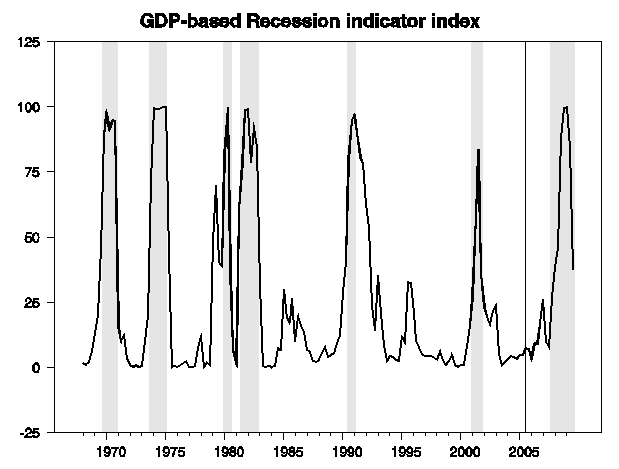The Bureau of Economic Analysis reported today that the seasonally adjusted real value of the nation’s production of goods and services grew at a 5.7% annual rate during the fourth quarter. That’s great news, but…

|
Three-fifths of that Q4 GDP growth came from the fact that businesses were drawing down inventories more slowly than they had the quarter before. Firms sold $8.5 billion more goods (at a quarterly rate) in 2009:Q4 than they produced, and met those sales by drawing down inventories by $8.5 billion. This reduction in inventories counts as negative investment spending of -$8.5 billion at a quarterly rate (or -$34 B at the annual rate these numbers are typically reported) for purposes of calculating fourth-quarter GDP. Firms sold $34.8 billion more than they produced in 2009:Q3, which amounted to negative inventory investment of -$139 B at an annual rate for Q3. Since this component of investment spending went from -139 to -34, it counts as positive growth when you compare Q3 GDP with Q4 GDP. This mechanism alone contributed 3.4 percentage points to the 5.7% growth rate for real GDP reported for Q4.
To put it another way, if consumers, businesses, foreigners, and the government had all purchased exactly the same quantity of real goods and services in 2009:Q4 as they had in 2009:Q3, more of those sales would have come out of inventory drawdown in Q3 than in Q4, so even without any gain in final sales we would have had to produce more stuff in Q4 than Q3, specifically, 3.4% more stuff at an annual rate. In fact real final sales to consumers, businesses, foreigners, and the government were not stagnant, but grew at a 2.3% annual rate during the fourth quarter, and the two effects combined give us the 5.7% reported GDP growth.

Just because the production gains can be accounted for in terms of slower inventory drawdown doesn’t mean they aren’t real, and doesn’t mean they can’t continue. I noted in July that we might expect inventory restocking to add 1.6% to the annual GDP growth rate for each of the first four quarters of the economic recovery, and we haven’t even yet begun that inventory restocking process. The question, though, is what we’ll see for the other components of GDP. Exports grew more than imports in Q4, with the result that net exports contributed 0.5 percentage points to that 2.3% growth in real final sales. That’s certainly a very welcome development and a critical step for correcting the imbalances that have been very troubling over the last decade.
Government spending made no contribution to Q4 growth, which again is a consequence of the algebra of growth rates— since real government purchases in Q4 were about what they had been in Q3, they made zero contribution to the growth rate, which is based on the change between Q4 and Q3. Fixed investment contributed 0.4 percentage points and consumption 1.4 percentage points to the 2.3% growth in real final sales and to the 5.7% growth in real GDP. Those are better numbers for consumption and fixed investment than we’d been seeing in the first half of the year, but not the sort you’d expect if a normal strong recovery was now fully in play.
The new GDP numbers allow us to update the Econbrowser Recession Indicator Index for the preceding quarter (2009:Q3), which now stands at 37.6%. This is a pattern recognition algorithm for dating business cycle expansions and contractions that waits one quarter for data revisions and clear trend identification before making an assessment. The value of 37.6 means that the preponderance of evidence favors the inference that the recovery began in 2009:Q3. However, the index has not yet crossed the 33% threshold at which, according to our predetermined rule, we would declare the recession to be over. Once the threshold is crossed, we will use the full set of revised data available at that time to assign a most probable date for the beginning of the expansion. If the currently reported 5.7% growth holds up under data revisions, I would expect the algorithm to generate on April 30 a formal declaration that the recovery began with the weak growth of 2009:Q3.

|
Bit of a tangent, BUT …
I have always found it interesting that for what I believe is every quarterly GDP report for the United States that I have ever seen, going back decades, it has been introduced with a “but …” in most discussion, no matter how positive it would seem. I cannot recall that sort of approach for many other nations (even when ‘downer’ information is presented alongside it, it’s often done with less of a “but here’s the real truth” tone), and it stands in stark contrast to the popular presentation of, say, Chinese GDP figures. Though some critics always look at Chinese GDP growth announcements with skepticism, for the most part any “but” is on the upside. “China’s growth slowed to X.X%, but lots of good things also happened or are showing signs of being about to happen.”
I don’t know if this is a product of transparency in data available for western economies as opposed to China’s, or if Americans are just constantly more focused on the negatives or potential negatives and feel the need to discuss them up front and focus on them, or if things really are worse than they seem for America going back decades, and really are at least as good if not better than they seem for China.
Somewhat related to that, MPO, have you noticed how nobody ever mentioned inventory adjustments in the midst of the recession? Only in the recovery, when you can use changes in inventory to argue things are worse than appear rather than better than appear, do the pundits talk about final demand.
Steve: Sounds like you weren’t here in April when I said: “On the bright side, inventory liquidation subtracted 2.8% from the quarter’s annual real GDP growth rate, meaning that real final sales were substantially better than GDP”
Prof,
I didn’t mean to specifically implicate you as doing that. You’re actually pretty even-handed on such issues.
What bothers me is when many pundits start referring to reports or data that they never considered before because it suits their needs now.
Depreciation of the dollar. Exports and imports reacted as expected. Mission accomplished: we exported the crisis (clapping hands very slowly…)
Well, I not a fan of efficient market theory, but….
Stock market finally sold off in the later part of the day, longer term treasuries rallied a bit(recessions make them happy), and The Three Horseman cometh…dollar rally continuing, yen even stronger lately, and ultra short t-bills dipping in the negative ranges. These all indicate risk aversion has returned.
Risk aversion has returned only for few weeks. Market upturn will continue till August. Then fluctuations will begin, which will finalize with a substantial drop in spring-March-April of 2011. Perhaps >30% in DOW ( 12000-> 9000).
During that drop, the impact of Lehman crisis will finally wade, and market will start to look for a new big FAD to drive it forward, perhaps one coming from outside the USA (China having problems from overheating and starting to act irrationally, also on the USA debt issues-Or NOT).
If China USA relations remain fine, and there are no new positive fads market will gain a bit before plunging again in Spring 2012.
Ivars,
True, only Three of Four Horsemen have come into view, and Three Horsemen does not Armageddon make.
I think the the Fourth Horseman (I keep typing Hoseman, in a Freudian slip) is “credit crunch”, and we can use our favorite indicators here, Libor rates, TED spread, etc…but that fellow is not in sight.
And I think there are many more than Four Horseman, but Biblical references are inadequate to describe the threat, so we refer to these as “Black Swans”.
Unfortunately, the government chooses not to look out for Black Swans, preferring instead to tell us that we won’t know a Black Swan until it flies overhead and craps on us.
They think this will keep the paranoia level of the unwashed masses at acceptable levels.
However, I can’t help feeling nervous at times and think that China owning so much of the Treasury is one of those hard to see Black Swans, and would like to propose a name for it.
Peg-asus.
The change in trade probably was much more a function of the stage of the business cycle rather than any impact of the dollar.
Cash for clunkers effect:
Auto sales (level in Billions)
Q1:2009 = 311.2,
Q2:2009 = 306.2,
Q3:2009 = 335.2,
Q4:2009 = 314.7,
from Table 3.–Gross Domestic Product and Related Measures: Level and Change From Preceding Period.
Nice example of a transitory effect and the impact that special interests (unions) can have on public policy.
Cedric,
True, I think that Lehman crisis may still whip a final blast with its tail, before leaving. During 2011.
That is one thing SURE Black Swan thing economies/politics should be prepared for.
It could be China since its political system is not prepared for dealing with sharp overheating crisis in a civilized way. So, even if economically China crisis would not be as big issues as USA/West caused banking crisis, politically it may be even bigger problem.
Ivars,
As far as China goes, we are seeing case by case issues filed with the WTO over specific industries being damaged, and the WTO is backing the US.(steel pipe and grating so far, but I hear hundreds of suits have been filed) So someday China may e-evaluate its need to buy treasuries and peg, or maybe they even may need their existing investment back to deal with internal problems. But I have been reading about China worries since 2004, so anything here moves slowly.
As far as other potential Black Swans go, someday we need to do the Mistake of 1938 2010, or 2011, or 2012…with a combination of liquidity draining, rate hikes, fiscal deficit reduction(read..higher taxes), Basel III capital increases and if the government doesn’t do it, eventually bond vigilantes will. This will not be painless, and I don’t see any way around it.
Then the flying PIIGS may fall out of the sky.
Also, the stock market has a PE problem, imo. We still have Great Bull Market PE ratios, and if you believe we are in a long term 2% growth economy instead of 4%, and the stock market is a discounting mechanism, then something don’t compute there.
Similar problems with fixed income markets.
Don’t ask me to time when these things happen. I have no idea.
But John Mauldin just released an e-letter dissecting the 4Q GDP report. Makes some good points about the “hollowness” of it.
“This Time It’s Different”
http://www.investorsinsight.com/
Then over at Zero Hedge, Tyler just published Goldman’s 2010 and 11 earnings forecast. An eye popping 38% for 2010 and 21% for 2011.
http://www.zerohedge.com/article/weekly-chartology-and-prophetology
Read these side by side and someone has to be crazy.
Cedric,
I read “This time is different” and it puts things in very nice historic perspective. Some country is going to default soon, and this may trigger next instability round via confidence loss in all national debts (Iceland as first trigger? Greece? Spain?….).
Goldman I think uses propaganda to overheat stock/commodity markets with their announcements, and somehow profit from it. I do not know, is it allowed? Its a conscious game. They did it in 2008 with oil, I remember, calling for 200USD oil during 2008.
With all apologizes to Pr Hamilton for expanding the digression made on his elected subject: Strong GDP growth with weak fundamentals
There has been no Lehman crisis per se as all banks were and still are in dire straights. Two banks were let gone, Bear and Stern and Lehman.
Lehman by itself drove the maximum foreign creditors loss of 660 billion USD, its fate was sealed by JP Morgan short term partially secured lender, with very short term funding. The plug was pulled by the same bank.
To think Lehman to be worse than today s banks shifting their non performing assets in off balance sheet may be self indulgence.
There are no PIIGS but BOVINE speculators fainting to ignore the treaty of the Union s content,European countries are not several and joint in debts.
All said the fundamentals are still very weak as none of the miles stones for a debt growth balancing, decreasing the profit shares of the financial versus the profit share of the non financial are met or close to it.
Does anyone remember that 3rd QTR was revised down 30%?
Also Professor I note your comment on the aggregate: In fact real final sales to consumers, businesses, foreigners, and the government were not stagnant, but grew at a 2.3% annual rate during the fourth quarter. In fact consumer domestic demand declined from 2.3% in the 3rd QTR to 1.7% in the 4th QTR, not unususal given the inventory increase. But that means that the fact that 90% of the 3rd QTR increase was due to government “stimulus” spending it appears that government spending will account for a significant portion of the 2.3% increase you mention (probably greater than 2.3% since it had to offset the domestic decline.)
While this GDP increase is reported as good news the details still signal a sluggish or perhaps even a declining economy.
Ivars,
I remember Goldman’s $200 oil call too. Then the commodity regulator did a study of oil contracts and found that Goldman was the single biggest owner.
The “pump and dump” of individual stocks is supposed to be “illegal”. Firms have to keep their research depts separate from the trading group. But there is nothing illegal about being wrong about forecasts.
But everyone knows that 2009 earnings were goosed by layoffs, top line revenue was flat, that can’t continue forever, and companies are supposed to start hiring again if the economy is going to get better. So I’d call the Goldman forecast extreme optimism.
I have been hearing moaning from traders on CNBC that the “retail” investor hasn’t really returned to stocks…most new money going towards bonds(treasuries largely). On Wall Street, “retail investor” is synonymous with “bagholder”. Could be the reason for the optimism.
Sounds like Greece is next. Possibilities in the news that I’ve seen are IMF bailout, Germany bailout(why?), and outright default.
Cedric
I was the “bagholder” myself:)in previous cycle. Now I hope they return, too. At least until the next milking. Which comes when I do not know. Perhaps during spring 2011, definitely during spring 2012.
I am from Latvia, so I know well what spending cuts are. If Greece for some reason can not do it -as they prefer to forecast increase in tax revenues ( ??) , than … given how EUR functions, that and Spain will cause a small devaluation of EUR during 2010, which is not so bad.
I wonder what would be the ricochets of Icelandic default? “This time is different” indicates more defaults should follow,simply because of fear, but EUR will not allow them , so there will be these alternative wealth destruction mechanisms at work, like devaluation of EUR?
Is Iceland a Lehman in country finances? What if they let it default?
Everyone is rather unsure about how the Eurozone will function under these circumstances. The ECB says it’s their job to supply liquidity to the banking system, but funding sovereign debt is the job of sovereigns. I think France and Germany are balking at the thought of backstopping the whole Eurozone. Part of the Euro membership agreement is that countries don’t pile up unsustainable debt, so Spain(here the problem is personal debt, not government debt, I read), Italy, Portugal, and Greece have basically violated the rule.
However, the Euro is overvalued, inflation is low, so the ECB has some latitude to devalue the Euro. This does seem to be happening lately, tho I don’t know if it’s Trichet that’s doing it.
So we’ll have to see what happens there.
I think Iceland is a goner already, their banks did them in and we are just waiting for it to be official. Don’t know how interconnected that is however. We may get fear, sort of like fear of Dubai, but it blows over fast because it’s “small” relative to the scope of things. Not like Britain going down, London leading the way.
Maybe the Icelanders will just move to Latvia. It’s warmer there and there are only enough Icelanders to make a medium size city anyway. Got any land you can turn over to them?
Cedric,
Sure they are welcome with all the territories and water,whales, thermal power and oil becoming our possession, but not debt. We could run a nation improvement experiment, since, in general,Icelanders are sturdy people, good breed.
They will anyway one day have to leave as the island breaks up along the Mid Atlantic Ridge.
If it is EUR devaluation in 2010, I am happy, as our currency is pegged to EUR, does not help to get via crisis easily.
Ivar,
Ok, sounds like a plan. One less thing for the US to do.
I don’t want so sound like I am pumping the Zero Hedge site (disclosure:I get no revenue from sending them web page hits) but they just published a detailed review of the Greece situation.
http://www.zerohedge.com/article/greek-defaultbailout-flowcharting-dominoes
Professor,
I am somewhat new to this but what is the largest revision ever made regarding Quarterly GDP when final data is released after initial data?
Thanks.